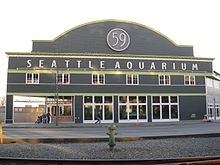Seattle Aquarium
 | |
| Date opened | May 20, 1977[1] |
|---|---|
| Location | Pier 59 Seattle, Washington, U.S. |
| Coordinates | 47°36′28″N 122°20′35″W / 47.6076966°N 122.3431277°WCoordinates: 47°36′28″N 122°20′35″W / 47.6076966°N 122.3431277°W |
| Volume of largest tank | 400,000 US gal (1,500,000 l)[2] |
| Annual visitors | 836,720 (2009)[3] |
| Memberships | AZA[4] |
| Website | www |
The Seattle Aquarium is a public aquarium in Seattle, Washington, United States, located on Pier 59 on the Elliott Bay waterfront. It opened in 1977 and has been accredited by the Association of Zoos and Aquariums (AZA).
History[]
The aquarium opened on May 20, 1977, and was initially owned and operated by the City of Seattle's Department of Parks and Recreation. On July 1, 2010, the nonprofit - the official 501(c)(3) nonprofit organization for the aquarium - assumed management of the institution from the city.[5] Bassetti/Norton/Metler/Rekevics were the architects for the building.[6]
The aquarium promotes marine conservation and educates over 800,000 visitors each year (including 50,000 students) on the impact of mankind on marine life. It also conducts research in these fields. In 2007, an 18,000-square-foot (1,700 m2) expansion added a 2,625-square-foot (243.9 m2) gift store and café to the aquarium, as well as two new exhibits: Window on Washington Waters and Crashing Waves.
Exhibits[]



- Window on Washington Waters is a 120,000-US-gallon (450,000 l) tank created as part of the 2007 expansion. It is meant to replicate the coastal waters of Washington state from about 5 to 60 feet (1.5 to 18.3 m), and feature native marine life including salmon, rockfish, and sea anemones. There are dive shows which take place several times a day. Divers wearing special masks are able to converse with visitors.[7][8]
- The Crashing Waves Exhibit is a 40-foot (12 m) wave tank that replicates Washington shores from the intertidal zone to a depth of about 5 feet (1.5 m).[8][9]
- Life on the Edge was opened in 2002. Two large exhibit pools that include touch zones allow visitors to see the tidepool life of Washington's outer coast and of Seattle's inland sea.[10]
- Life of a Drifter includes a 12-foot (3.7 m) high glass "donut" where visitors can be surrounded by moon jellies, a multi-species display featuring the giant Pacific octopus, and a 13-foot (4.0 m) touch table where visitors can view some of the area's drifters including juvenile rockfish, sea stars, and plankton.[11]
- Pacific Coral Reef is a man-made coral reef in a 25,000-US-gallon (95,000 l) tank that contains fish that live in and around reefs.
- Ocean Oddities is an exhibit displaying pinecone fish, cowfish, flying gurnards, potbellied seahorses, and short dragonfish.
- Birds and Shores consists of three separate areas. Northwest Shores is an area which shows birds in a variety of habitats of the coastal Northwest. Alcids has diving birds such as tufted puffins and common murres. There is also a Shorebird exhibit.[12]
- The Marine Mammals area includes exhibits for harbor seals, Northern fur seals, sea otters, and river otters,[9] as well as the Orca Family Activity Center. The Orca Family Activity Center is meant to educate visitors about orcas, particularly those belonging to the Southern Resident Community residing in Puget Sound.[13]
- Puget Sound Fish is a three-part exhibit that contains fish from the Puget Sound. Fish included in the tank are grunt sculpins, Pacific spiny lumpsuckers, midshipman fish, canary rockfish, wolf eels, and decorated warbonnets.[14]
- The Underwater Dome is an exhibit viewed from a mostly transparent spherical undersea room in a 400,000-US-gallon (1,500,000 l) tank. It was built as part of the original construction and opened in 1977. The tank exhibits species that would be found in Puget Sound including salmon, Lingcod, sharks, sturgeon, skates, and rockfish.[2]
In popular culture[]
A fictionalized Seattle Aquarium is prominently featured in the 2020 action-adventure game The Last of Us Part II.[15]
Notes[]
- ^ "Seattle Aquarium". historylink.org. HistoryLink. Retrieved 27 February 2011.
- ^ Jump up to: a b "Underwater Dome". seattleaquarium.org. Seattle Aquarium. Retrieved 27 February 2011.
- ^ "Quick Facts". seattleaquarium.org. Seattle Aquarium. Retrieved 27 February 2011.
- ^ "Currently Accredited Zoos and Aquariums". aza.org. AZA. Retrieved 27 February 2011.
- ^ "Seattle Aquarium Society". seattleaquarium.org. Seattle Aquarium. Retrieved 28 November 2010.
- ^ "Bassetti Architects: Seattle Aquarium". bassettiarch.com. Bassetti Architects. Retrieved 18 March 2011.
- ^ "Window on Washington Waters". seattleaquarium.org. Seattle Aquarium. Retrieved 27 February 2011.
- ^ Jump up to: a b "Almost There: Work Continues on the Expanded Aquarium" (PDF). Currents. Seattle, Washington: Seattle Aquarium Society (Spring 2007): 3. Retrieved 27 February 2011.
- ^ Jump up to: a b "Welcome to Seattle Aquarium". seattleaquarium.org. Seattle Aquarium. Retrieved 27 February 2011.
- ^ "Life on the Edge". seattleaquarium.org. Seattle Aquarium. Retrieved 27 February 2011.
- ^ "Life of a drifter". seattleaquarium.org. Seattle Aquarium. Retrieved 27 February 2011.
- ^ "Birds and Shores". seattleaquarium.org. Seattle Aquarium. Retrieved 27 February 2011.
- ^ "Orca Family Activity Center". seattleaquarium.org. Seattle Aquarium. Retrieved 27 February 2011.
- ^ "Puget Sound Fish". seattleaquarium.org. Seattle Aquarium. Retrieved 27 February 2011.
- ^ "PlayStation's The Last of Us Part II features a post-pandemic Seattle | Venture". dailyhive.com. Retrieved 2021-04-18.
External links[]
 Media related to Seattle Aquarium at Wikimedia Commons
Media related to Seattle Aquarium at Wikimedia Commons- Official website
- Aquaria in Washington (state)
- Culture of Seattle
- Buildings and structures in Seattle
- 1977 establishments in Washington (state)
- Zoos established in 1977
- Tourist attractions in Seattle
- Central Waterfront, Seattle
